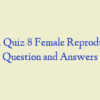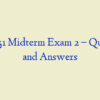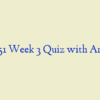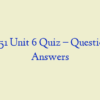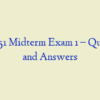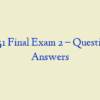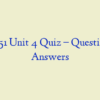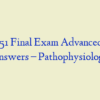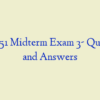Description
MN 551 Quiz 3 – Question and Answers
1.The nurse practitioner for a cardiology practice is responsible for providing presurgical teaching for patients who are about to undergo a coronary artery bypass graft. Which of the following teaching points best conveys an aspect of the human circulatory system?
- A physical assessment of a 28-year-old female patient indicates that her blood pressure in her legs is lower than that in her arms and that her brachial pulse is weaker in her left arm than in her right. In addition, her femoral pulses are weak bilaterally. Which of the following possibilities would her care provider be most likely to suspect?
- As part of the diagnostic workup for a male patient with a complex history of cardiovascular disease.
- The care team has identified the need for a record of the electrical activity of his heart, insight into the metabolism of his myocardium, and physical measurements, and imaging of his heart. Which of the following series of tests is most likely to provide the needed data for his diagnosis and care?
- An older adult female patient has presented with a new onset of shortness of breath, and the patient’s nurse practitioner has ordered measurement of her BNP levels along with other diagnostic tests. What is the most accurate rationale for the nurse practitioner’s choice of blood work?
- A patient in the intensive care unit has a blood pressure of 87/39 and has warm, flushed skin accompanying his sudden decline in level of consciousness. The patient also has arterial and venous dilation and a decrease in systemic vascular resistance. What is this patient’s most likely diagnosis?
- A number of patients have presented to the emergency department in the last 24 hours with complaints that are preliminarily indicative of myocardial infarction.
- Which of the following patients is least likely to have an ST-segment myocardial infarction (STEMI)?
- A 54-year-old man with a long-standing diagnosis of essential hypertension is meeting with his nurse practitioner. The patient’s nurse practitioner would anticipate that which of the following phenomena is most likely occurring?
- A 66-year-old obese man with a diagnosis of ischemic heart disease has been diagnosed. With heart failure that his care team has characterized as attributable to systolic dysfunction. Which of the following assessment findings is inconsistent with his diagnosis? (Points : 3)
- Which of the following assessment findings in a newly …..30-year-old male patient would be most likely to cause his nurse practitioner to suspect polyarteritisnodosa?
- A 6-year-old boy has been brought to the emergency department by ambulance after his mother discovered that. His heart rate was “so fast I couldn’t even count it.” The child was determined to be in atrial flutter and his mother is seeking an explanation from the health care team. Which of the following points should underlie an explanation to the mother? mn 551 quiz 3
- A patient has suffered damage to his pericardium following a motor vehicle accident. Which of the following consequences should the nurse practitioner be most likely to rule out?
- Which of the following situations related to the transition from fetal to perinatal circulation would be most likely to necessitate medical intervention?
- A 70-year-old male patient presents to the emergency department complaining of pain in his calf that is exacerbated when he walks.
- His pedal and popliteal pulses are faintly palpable and his leg distal to the pain is noticeably ….. What would his care provider preliminary diagnosis and anticipate treatment most likely be?
- A patient is experience impaired circulation secondary to increased systemic arterial pressure. Which of the following statements is the most relevant phenomenon? increased pressure in the aorta and other arteries constitutes a greater amount of afterload work. This situation is not indicative of increased preload or impaired contractility. Systolic impairment is not a recognized characterization of inadequate cardiac performance. mn 551 quiz 3
- A nurse practitioner is providing care for several patients on a medical unit of a hospital. In which of the following patient situations would the nurse practitioner be most likely to rule out hypertension as a contributing factor?
- A formerly normotensive woman, pregnant for the first time, develops hypertension and headaches at 26 weeks’ gestation. Her blood pressure is 154/110 mm Hg and she has proteinuria. What other labs should be order for her?
- A nurse practitioner is instructing a group of older adults about the risks associated with high cholesterol. Which of the following teaching points should the participants try to integrate into their lifestyle after the teaching session?
- An autopsy is being perform on a 44-year-old female who died unexpectedly of heart failure. Which of the following component of the pathologist’s report is most suggestive of a possible history of poorly controlled blood pressure?
- A nurse practitioner has ordered the measurement of a cardiac patient’s electrolyte levels as part of the patient’s morning blood work.
- Which of the following statements best captures the importance of potassium in the normal electrical function of the patient’s heart?
- In which of the following patient situations would a nurse practitioner be most justified in preliminarily ruling out pericarditis as a contributing pathology to the patient’s health problems ?
- During a routine physical examination of a 66-year-old woman, her nurse practitioner notes a pulsating abdominal mass and refers the woman for further treatment. The nurse practitioner is explaining the diagnosis to the patient, who is unfamiliar with aneurysms. Which of the following aspects of the pathophysiology of aneurysms would underlie the explanation the nurse provides? mn 551 quiz 3
- A 66-year-old patient’s echocardiogram reveals a hypertrophied left ventricle, normal chamber volume, and a normal ejection fraction from the heart. What is this patient’s most likely diagnosis?
- A nurse practitioner is teaching a student NP about the physiologic basis for damage to the circulatory. And neurological systems that can accompany hypotension. Which of the following responses by the student would warrant correction by the nurse practitioner?
- An 81-year-old female patient of a long-term care facility has a history of congestive heart failure. The nurse practitioner caring for the patient has positioned her sitting up at an angle in bed and is observing her jugular venous distention. Why is jugular venous distention a useful indicator for the assessment of the patient’s condition?
- What immediate treatments are likely to most benefit the man?
![]()

